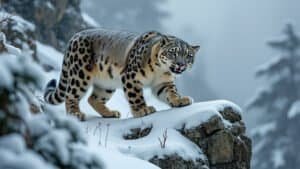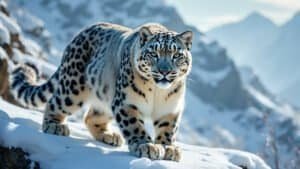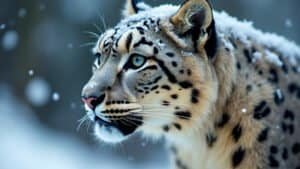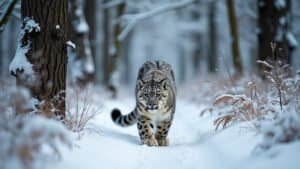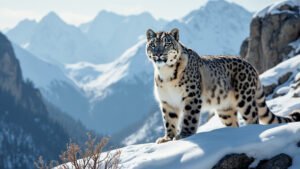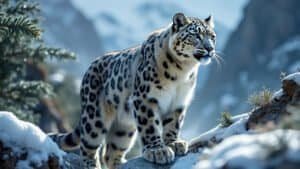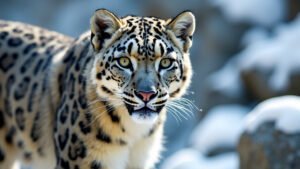Introduction
Snow leopards, known for their elusive nature and striking appearance, inhabit some of the most remote and rugged mountain regions in the world. Despite being isolated in these harsh terrains, snow leopards maintain genetic diversity, a crucial factor for their survival
This article will explore the various adaptations and strategies snow leopards use to preserve genetic diversity, the importance of gene flow between isolated populations, the role of habitat connectivity, and the impact of genetic diversity on their survival
We will also examine the threats to their genetic diversity and the conservation efforts in place to protect these magnificent creatures
Adaptations That Support Genetic Diversity
Snow leopards have evolved several unique adaptations that help them maintain genetic diversity despite living in isolated and fragmented habitats. These adaptations, spanning behavioral, physical, and reproductive strategies, are crucial for ensuring their long-term survival and genetic health
Behavioral Adaptations
Snow leopards exhibit several behavioral adaptations that contribute to maintaining genetic diversity. One of the most significant is their extensive home range
A single snow leopard’s territory can cover hundreds of square miles, allowing them to encounter and mate with individuals from different populations. This wide-ranging behavior reduces the likelihood of inbreeding and promotes genetic exchange
Another critical behavioral adaptation is their solitary nature, which, paradoxically, supports genetic diversity. By living alone except during mating season or when raising cubs, snow leopards avoid overexploitation of localized resources and minimize competition
This solitary lifestyle ensures that when they do meet another leopard for mating, it is likely from a different genetic pool, enhancing genetic mixing
Snow leopards also communicate through scent markings and vocalizations. These signals help them locate potential mates across vast distances. Scent markings can convey a wide range of information, including the identity, sex, and reproductive status of the leopard, aiding in the identification of genetically suitable mates
Physical Adaptations
Physically, snow leopards possess several adaptations that enable them to traverse and thrive in the rugged mountainous regions they inhabit
Their powerful legs and large paws are adapted for climbing steep, rocky terrains, allowing them to move between isolated areas more easily. This physical capability is crucial for accessing different populations and facilitating genetic exchange
The thick fur and large nasal cavities of snow leopards are also adaptations to their cold, high-altitude environment. These features enable them to survive in harsh conditions, ensuring that they can live and reproduce in isolated regions where few other predators can survive
This ecological niche reduces competition and allows snow leopards to spread out over larger areas, promoting genetic diversity
Reproductive Strategies
Reproductive strategies in snow leopards are also geared towards maintaining genetic diversity. Female snow leopards come into estrus once a year, and during this period, they may mate with multiple males
This polyandrous behavior increases the chances of genetic variation in their offspring. Studies have shown that litters can have multiple paternities, which significantly enhances genetic diversity within a population
Additionally, snow leopards have a relatively long reproductive lifespan. Females can reproduce from around the age of three until they are about 15 years old. This extended reproductive period allows for more opportunities to mate with different partners over a lifetime, further contributing to genetic diversity
In the wild, cubs stay with their mothers for up to two years, learning essential survival skills. This extended maternal care ensures that young snow leopards are well-prepared for independence, increasing their chances of survival and successful reproduction, which supports genetic diversity within the population
Gene Flow Between Isolated Populations
Gene flow, the transfer of genetic material between populations, is crucial for maintaining genetic diversity among snow leopards, particularly those living in isolated regions
Despite the challenges posed by their fragmented habitats, various natural and human-made mechanisms facilitate gene flow, helping to ensure the long-term survival of these majestic animals
Natural Corridors
Natural corridors are essential for enabling gene flow between isolated snow leopard populations. These corridors are continuous tracts of suitable habitat that connect otherwise fragmented areas, allowing snow leopards to travel and mate with individuals from different populations
Mountain ranges, river valleys, and other geographic features often serve as these natural pathways
For example, the Himalayas and the Tibetan Plateau provide extensive natural corridors that connect various snow leopard habitats across multiple countries. These corridors allow snow leopards to move between regions, thereby facilitating genetic exchange and reducing the risk of inbreeding
Studies have shown that snow leopards can travel significant distances, sometimes over 40 miles in a single day, to find mates, highlighting the importance of these natural pathways
Human-Made Solutions
In areas where natural corridors are disrupted or insufficient, human-made solutions play a vital role in promoting gene flow
Wildlife corridors, underpasses, and overpasses are engineered structures designed to help animals cross barriers such as roads, railways, and urban developments safely
Conservation organizations and governments have implemented several initiatives to create and maintain these structures. For instance, in regions like Central Asia, conservationists have worked on establishing wildlife corridors that connect fragmented snow leopard habitats
These efforts include negotiating with local communities and authorities to secure protected migration routes and constructing wildlife-friendly infrastructure
Additionally, translocation programs, where individuals from one population are moved to another, have been used to enhance genetic diversity. These programs are carefully planned to ensure the introduced animals can integrate into the new population, contributing to its genetic pool without causing undue stress or competition
Genetic Studies on Gene Flow
Genetic studies have provided valuable insights into the gene flow between isolated snow leopard populations. By analyzing DNA samples from various populations, researchers can determine the extent of genetic exchange and identify genetic bottlenecks or isolated populations at risk of inbreeding
One such study, conducted by the Snow Leopard Trust and its partners, involved collecting and analyzing scat samples from different regions
The study revealed significant gene flow between populations in Mongolia and the surrounding areas, indicating that natural corridors were effectively facilitating genetic exchange. These findings underscore the importance of preserving and protecting these corridors to ensure the continued flow of genetic material
Moreover, genetic research has highlighted the impact of human activities on gene flow. For example, habitat fragmentation caused by infrastructure development has been shown to impede gene flow, leading to isolated populations with reduced genetic diversity
These insights have driven conservation strategies aimed at mitigating the impact of human activities and enhancing connectivity between habitats
Importance of Habitat Connectivity
Habitat connectivity is essential for the survival of snow leopards, facilitating movement, breeding, and access to resources
By ensuring that these elusive cats can navigate through their fragmented environments, connectivity supports genetic diversity and overall population health. This section will explore the role of corridors, conservation efforts, and case studies that highlight the importance of connected habitats
Role of Corridors
Habitat corridors are strips of natural habitat that connect isolated patches, allowing animals to move freely between them. For snow leopards, these corridors are critical for accessing different populations, finding mates, and expanding their territory
In the mountainous regions where snow leopards live, natural corridors often follow ridgelines, river valleys, and forested paths
These pathways are crucial for maintaining genetic diversity, as they enable leopards from different areas to interbreed. Without these corridors, populations could become genetically isolated, leading to inbreeding and a reduction in genetic health
One example of an effective corridor is the high-altitude ridge systems in the Himalayas, which connect various snow leopard habitats across Nepal, India, and Bhutan. These ridges allow snow leopards to traverse vast distances, ensuring genetic exchange between populations
Protecting these natural corridors from human encroachment is vital for the conservation of snow leopards
Conservation Efforts
Numerous conservation initiatives focus on enhancing habitat connectivity for snow leopards. Organizations like the Snow Leopard Trust, Panthera, and WWF collaborate with local governments and communities to implement strategies that preserve and restore corridors
One significant effort is the creation of transboundary protected areas, which span multiple countries and safeguard critical habitats and corridors. For instance, the transboundary landscape in the Altai-Sayan region covers parts of Russia, Mongolia, Kazakhstan, and China, providing a vast, connected habitat for snow leopards
Conservationists also work to mitigate the impact of infrastructure development, such as roads and railways, which can fragment habitats
Wildlife crossings, including underpasses and overpasses, are constructed to allow snow leopards and other wildlife to safely cross these barriers. Additionally, land-use planning and zoning regulations are implemented to ensure that new developments do not disrupt crucial corridors
Community engagement is another key aspect of conservation efforts. By involving local communities in habitat protection and management, conservationists can foster sustainable practices that benefit both people and wildlife
Programs that promote eco-friendly livelihoods, such as sustainable herding practices and eco-tourism, help reduce human-wildlife conflicts and ensure the long-term viability of habitat corridors
Case Studies
Several case studies demonstrate the effectiveness of habitat connectivity initiatives. In the Tost Mountains of Mongolia, a community-based conservation program has successfully established a network of protected areas and corridors
This initiative, led by the Snow Leopard Trust, involves local herders in monitoring and protecting snow leopards and their habitats. The program has resulted in increased sightings of snow leopards and improved genetic diversity in the population
Another case study is the establishment of the Kangchenjunga Conservation Area in Nepal. This protected area connects snow leopard habitats across Nepal and India, facilitating gene flow and movement
Conservation efforts in this region include anti-poaching patrols, habitat restoration, and community education programs. The success of these initiatives is reflected in the stable population of snow leopards and the preservation of critical corridors
In Kyrgyzstan, the Ala-Too Conservation Initiative focuses on maintaining habitat connectivity in the Tian Shan mountains. This project involves the creation of wildlife corridors, anti-poaching efforts, and community engagement. The initiative has led to a reduction in poaching incidents and the preservation of essential corridors for snow leopards
Impact of Genetic Diversity on Survival
Genetic diversity plays a crucial role in the survival of snow leopards, influencing their health, reproductive success, and ability to adapt to changing environments
This section delves into how genetic diversity affects various aspects of snow leopard survival, including health and disease resistance, reproductive success, and long-term viability
Health and Disease Resistance
Genetic diversity is fundamental to the health and disease resistance of snow leopards
Populations with high genetic diversity have a broader range of genetic traits, which enhances their ability to withstand diseases and environmental stressors. This diversity reduces the likelihood that a single disease or environmental change will devastate the entire population
Studies have shown that genetic diversity can improve immune system function in wildlife. For snow leopards, a genetically diverse population is better equipped to fend off common diseases and parasites. In contrast, inbreeding within isolated populations can lead to a higher prevalence of genetic disorders and a weakened immune system, making these populations more susceptible to diseases
For example, a genetic study conducted by the Snow Leopard Trust found that snow leopard populations in the Tien Shan mountains had higher genetic diversity compared to those in more isolated regions
This diversity correlated with lower incidences of disease and better overall health, underscoring the importance of maintaining genetic diversity for disease resistance
Reproductive Success
Genetic diversity also impacts the reproductive success of snow leopards. Diverse genetic traits increase the likelihood of producing healthy offspring with a better chance of survival. In populations with low genetic diversity, inbreeding can lead to reduced fertility and higher rates of congenital defects
One of the significant reproductive challenges faced by snow leopards in isolated populations is the reduced availability of genetically diverse mates
This limitation can result in inbreeding, where closely related individuals mate, leading to inbreeding depression. Inbreeding depression manifests as reduced fitness, lower fertility rates, and increased infant mortality, all of which threaten the survival of the population
To counteract these effects, snow leopards have evolved mating strategies that promote genetic diversity, such as polyandry, where females mate with multiple males. This strategy increases the genetic variability of their offspring, enhancing their chances of survival and reproduction
Long-Term Viability
The long-term viability of snow leopard populations is heavily dependent on genetic diversity. Genetic diversity provides the raw material for evolution, enabling populations to adapt to changing environments
In the face of climate change, habitat loss, and other anthropogenic pressures, genetic diversity is crucial for the adaptability and resilience of snow leopards
Populations with high genetic diversity are more likely to possess individuals with traits that allow them to thrive under new conditions. This adaptability is essential for survival as snow leopards face challenges such as shrinking habitats, changing prey availability, and increasing human-wildlife conflict
For example, climate change is expected to alter the snow leopard’s habitat significantly, affecting both temperature and prey distribution. Populations with greater genetic diversity will have a higher likelihood of containing individuals with traits suited to these new conditions, ensuring the species’ continued survival
Threats to Genetic Diversity
Snow leopards face numerous threats that endanger their genetic diversity. Habitat fragmentation, poaching, human interference, and climate change all play significant roles in diminishing the genetic health of snow leopard populations
This section examines these threats and their impact on the genetic diversity of snow leopards
Habitat Fragmentation
Habitat fragmentation is one of the most significant threats to the genetic diversity of snow leopards. As human activities expand into mountainous regions, the natural habitats of snow leopards become increasingly fragmented
Roads, villages, and agricultural developments create physical barriers that prevent snow leopards from moving freely and accessing different populations
Fragmentation leads to smaller, isolated populations that have limited opportunities for genetic exchange. These isolated populations are at a higher risk of inbreeding, which can result in inbreeding depression and a loss of genetic diversity
For example, the construction of roads in the Himalayas has fragmented snow leopard habitats, leading to reduced gene flow and increased isolation of populations
Efforts to mitigate habitat fragmentation include the creation of wildlife corridors and protected areas that connect fragmented habitats. These initiatives aim to restore connectivity and facilitate the movement of snow leopards, thereby enhancing genetic exchange and diversity
Poaching and Human Interference
Poaching and human-wildlife conflict are significant threats to snow leopards and their genetic diversity
Snow leopards are often targeted for their fur, bones, and other body parts, which are highly valued in illegal wildlife trade. Additionally, herders sometimes kill snow leopards to protect their livestock
Poaching reduces the number of individuals in a population, leading to smaller, more isolated groups. This reduction exacerbates the risk of inbreeding and genetic bottlenecks, where a few individuals contribute disproportionately to the gene pool. For instance, poaching in the Altai Mountains has significantly decreased snow leopard numbers, leading to a decline in genetic diversity in that region
Human interference, such as habitat destruction and resource competition, further exacerbates the problem
Efforts to combat poaching and human interference include anti-poaching patrols, community education programs, and compensation schemes for livestock losses. These measures aim to reduce direct threats to snow leopards and promote coexistence between humans and wildlife
Climate Change
Climate change poses a growing threat to the genetic diversity of snow leopards by altering their habitats and prey availability. As temperatures rise and precipitation patterns shift, the alpine and subalpine ecosystems that snow leopards depend on are undergoing significant changes
Changes in temperature and snow cover can affect the distribution of prey species such as ibex and blue sheep, forcing snow leopards to move to new areas in search of food. This movement can lead to increased isolation of populations if suitable habitats become scarce or fragmented
Additionally, climate change can affect the reproductive success and survival rates of snow leopards, further reducing genetic diversity
A study published in the journal “Global Change Biology” highlighted the potential impact of climate change on snow leopard habitats, predicting a significant reduction in suitable habitats by 2070. These findings underscore the urgent need for climate-resilient conservation strategies that address the impacts of climate change on snow leopard populations
Conservation Efforts to Preserve Genetic Diversity
Conservation efforts are vital for preserving the genetic diversity of snow leopards, ensuring their long-term survival
This section explores various initiatives, including breeding programs, habitat protection, and international cooperation, that aim to maintain and enhance genetic diversity within snow leopard populations
Breeding Programs
Breeding programs play a crucial role in preserving genetic diversity among snow leopards
These programs aim to manage and increase the genetic variability of captive populations, which can serve as a genetic reservoir for wild populations. By carefully selecting breeding pairs based on genetic data, conservationists can minimize inbreeding and enhance genetic diversity
Zoos and conservation organizations worldwide participate in coordinated breeding programs. For instance, the Snow Leopard Species Survival Plan (SSP) in North America and the European Endangered Species Programme (EEP) are collaborative efforts that manage the genetic health of captive snow leopards
These programs involve meticulous genetic monitoring, data sharing, and strategic exchanges of individuals between institutions to ensure diverse genetic representation
Additionally, captive-bred snow leopards can potentially be reintroduced into the wild to bolster genetic diversity in struggling populations. Reintroduction efforts, however, require thorough planning to ensure that the released animals can adapt and integrate into their natural habitats successfully
Habitat Protection
Protecting and restoring natural habitats is fundamental for maintaining the genetic diversity of snow leopards
Conservation efforts focus on preserving large, contiguous tracts of land that provide the necessary resources and connectivity for snow leopards to thrive. Protected areas, national parks, and wildlife reserves are established to safeguard these critical habitats
One notable example is the establishment of the Snow Leopard Conservation Area in Nepal, which covers over 4,000 square miles of prime snow leopard habitat. This protected area aims to conserve vital ecosystems and facilitate gene flow between populations
Habitat protection efforts also involve mitigating human-wildlife conflicts and promoting sustainable land-use practices that benefit both wildlife and local communities
Reforestation and habitat restoration projects are also essential components of habitat protection. These initiatives restore degraded landscapes, creating more suitable habitats for snow leopards and improving connectivity between fragmented areas. By enhancing habitat quality and availability, these projects contribute to the genetic health of snow leopard populations
International Cooperation
International cooperation is critical for the conservation of snow leopards, given their wide-ranging habitats that span multiple countries. Cross-border conservation initiatives and agreements facilitate collaborative efforts to protect snow leopard habitats and enhance genetic diversity
The Global Snow Leopard & Ecosystem Protection Program (GSLEP) is a notable example of international cooperation
Launched in 2013, GSLEP brings together 12 range countries, including China, India, Russia, and Mongolia, to implement a comprehensive strategy for snow leopard conservation. The program focuses on securing 20 snow leopard landscapes by 2020, promoting habitat connectivity, and fostering transboundary cooperation
International organizations like the Snow Leopard Trust, Panthera, and WWF also play vital roles in coordinating and supporting conservation efforts across range countries
These organizations provide funding, expertise, and resources to implement effective conservation strategies. Collaborative research projects, capacity-building programs, and community-based conservation initiatives further enhance international cooperation
Community Involvement
Engaging local communities is essential for the success of conservation efforts. Community-based conservation programs empower local people to participate in and benefit from conservation activities. These programs promote sustainable livelihoods, reduce human-wildlife conflicts, and foster stewardship of natural resources
For example, the Snow Leopard Enterprises initiative involves local herders in conservation efforts by providing incentives for protecting snow leopards and their habitats
Herders receive training and support to produce and sell handicrafts, generating income while contributing to conservation goals. This approach not only improves the economic well-being of local communities but also builds strong conservation partnerships
Educational outreach programs are also crucial for raising awareness and garnering support for snow leopard conservation. By educating communities about the importance of genetic diversity and the threats facing snow leopards, these programs foster a sense of responsibility and commitment to conservation efforts
Conclusion
The survival of snow leopards depends heavily on maintaining genetic diversity, which is crucial for their health, reproductive success, and adaptability to changing environments. Through a combination of unique behavioral, physical, and reproductive adaptations, snow leopards enhance their genetic diversity
Gene flow between isolated populations, facilitated by natural corridors and human-made solutions, plays a vital role in sustaining genetic health. Habitat connectivity, supported by corridors and conservation efforts, ensures that snow leopards can traverse their fragmented environments and access different populations
However, threats such as habitat fragmentation, poaching, human interference, and climate change pose significant risks to their genetic diversity. Conservation initiatives, including breeding programs, habitat protection, international cooperation, and community involvement, are essential to preserving the genetic diversity and long-term survival of snow leopards
By addressing these challenges and promoting sustainable conservation strategies, we can ensure that these magnificent creatures continue to thrive in their natural habitats




